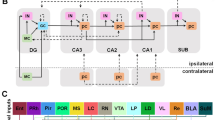Abstract
Mice, normally not susceptible to audiogenic seizures, can be made susceptible by exposing the animal to a loud auditory stimulus (priming) and then retesting the same animal at a later time (retest). δ 9-Tetrahydrocannabinol (THC) was found to decrease susceptibility when administered either prior to priming or prior to retest. This decrease in susceptibility was dependent upon both time and dose. The effectiveness of THC in blocking seizures when administered before priming points to a relatively unique action of this compound. In general, it appears the THC is active at loci involved in predetermining convulsive states precipitated by auditory stimuli.
Similar content being viewed by others
References
Bicher, H. I., Machoulam, R.: Pharmacological effects of two active constituents of marihuana. Arch. int. Pharmacodyn. 172, 24–31 (1968).
Bobbin R. P., Gonzalez, G., Guth, P. S.: Effects of aminooxyacetic acid on cochlear potentials and the Preyer reflex. Nature (Lond.) 223, 70 (1969).
Boggan, W. O., Freedman, D. X., Lovell, R. A., Schlesinger, K.: Studies in audiogenic seizure susceptibility. Psychopharmacologia (Berl.) 20, 48–56 (1971).
Bose B. C., Saifi, A. Q., Bhagwat, A. W.: Effect of cannabis indica on hexobarbital sleeping time and tissue respiration of rat brain. Arch. int. Pharmacodyn. 141 520–524 (1963).
Carlini, E. Z., Kramer, C.: Effects of Cannabis sative (marihuana) on maze performance of the rat. Psychopharmacologia (Berl.) 7, 175–181 (1965).
Dagirmanjian, R., Boyd, E. S.: Some pharmacological effects of two tetrahydrocannabinols. J. Pharmacol. exp. Ther. 135, 25–33 (1962).
Fuller, J. L., Collins, R. L.: Mice unilaterally sensitized for audiogenic seizures. Science 162, 1295 (1968).
Garattini S.: Effects of a cannabis extract on gross behavior. In: Hashish: its chemistry and pharmacology. G. Wolstenholme and J. Knight eds. Ciba Foundation Study Group no. 21. Boston: Little Brown 1965.
Garriott, J. C., King L. J., Forney, R. B., Hughes, F. W.: Effect of some tetrahydrocannabinols on hexabarbital sleeping time and amphetamine induced hyperactivity in mice. Life Sci. 6, 2119–2128 (1967).
Henry, K. R.: Audiogenic seizure susceptibility induced in C57BL/6J mice by prior auditory exposure. Science 158, 938–940 (1967).
Ho, B. T., Fritchie, E., Englert, L. F., McIsaac, E. M., Heikkila, J. E.: Marihuana: importance of the route of administration. J. Pharm. Pharmacol. 23, 309–310 (1971).
Holtzman, D., Lovell, R. A., Jaffe, J. H., Freedman, D. X.: 1-δ 9-tetrahydrocannabinol: neurochemical and behavioral effects in the mouse. Science 163, 1464–1467 (1969).
Kaymakcalan, S., Deneau, G. A.: Some pharmacological effects of synthetic δ 9-tetrahydrocannabinol (THC). Pharmacologist 12, 310 (1970).
Loewe, S., Goodman, L. S.: Anticonvulsant action of marihuana-active substances. Fed. Proc. 6, 352 (1947).
Phillips, R. N., Turn, R. F., Forney, R. B.: Acute toxicity of δ 9-tetrahydrocannabinol in rats and mice. Proc. Soc. exp. Biol. (N.Y.) 136, 260–263 (1971).
Santos, M., Sampaio, M. R. P., Fernandes, N. S., Carlini, E. A.: Effects of Cannabis sative (marihuana) on the fighting behavior of mice. Psychopharmacologia (Berl.) 8, 437–444 (1966).
Scheckel, C. L., Boff, E., Dahlen, P., Smart, T.: Behavioral effects in monkeys of racemates of two biologically active marihuana constituents. Science 160, 1467–1469 (1968).
Sofia, R. D., Solomon, T. A., Barry, H.: The anticonvulsant activity of δ 1-tetrahydrocannabinol in mice. Pharmacologist 13, 309 (1971).
Sze, P. Y.: Neurochemical factors in auditory stimulation and development of susceptibility to audiogenic seizures. In: Physiological effects of noise. B. L. Welch and A. S. Welch, eds. New York: Plenum Press 1970.
Truitt, E. B.: Pharmacological activity of a metabolite of 1-trans-δ 8-tetrahydrocannabinol. Fed. Proc. 29, 2095 (1970).
Author information
Authors and Affiliations
Additional information
This research was supported by research grants State of Illinois Public Welfare 17-302 and W. C. and J. V. Stone Foundation (W. O. B.).
Rights and permissions
About this article
Cite this article
Boggan, W.O., Steele, R.A. & Freedman, D.X. δ9-tetrahydrocannabinol effect on audiogenic seizure susceptibility. Psychopharmacologia 29, 101–106 (1973). https://doi.org/10.1007/BF00422641
Received:
Revised:
Issue Date:
DOI: https://doi.org/10.1007/BF00422641




